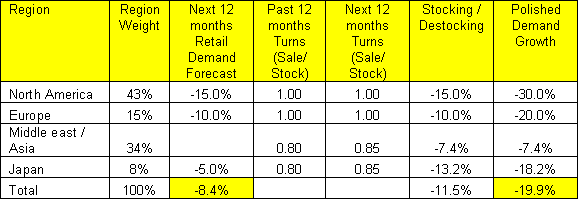A New Sound of Music: Indian Winter Blues
November 20, 08
One of the first victims in any crisis situation is ‘hard information’ – potentially impacted people are reacting to rumors, to uncertainties, and too often panic becomes the driver of ‘rational’ decision making. Just ask any banker
The industry’s major producers went on record that they will reduce rough supplies to the market. De Beers Managing Director summed it up: “Like any company in any industry today, we are fully prepared to reduce production to reflect the prevailing level of demand for new rough diamond supply from our clients.” Alrosa’s Sergey Vybornov gave similar assurances. He didn’t specify figures, but one Flemish newspaper reported that the company had received state authority to reduce sales by up to 40 percent of its output (and sell them to the state’s diamond and precious metals repository Gokhran.)
Though De Beers formally will determine the level of its reduced mining production only in February next year, insiders expect its output to be lower by some 20 percent. As much more is needed, its 2009 sales are likely to be consider
Alrosa, so far, has been reluctant to reduce its rough selling price as it is facing huge cost increases, a negative currency trend, and, measured in rubles, reported a staggering profit decline in its last quarter. Alrosa’s largest domestic client, the Smolensk-based Kristall, refused the lion’s share of its recent rough allocations which it finds far too expensive. Alrosa claims that it sold rough to De Beers at 26.5 percent
The rough diamond workshop at the Symposium, which attracted some 500 people, was near unanimous in its position that ‘rough diamonds need to fall an additional 20 percent before they are at the level dictated by processing costs and the resultant polished price’. A lone DTC sightholder, a rough dealer, dissented and felt that the current rough price is adequate.
The expected decline in rough prices is closely related to the producers’ decision on output reductions – and it must be assumed that not all producers (especially the alluvial ones) will show equal measures of self-restraint. At the end of the day, the size of the price reduction will depend on the size of the cutback. The larger the cutback, the smaller the price decrease – but a synchronization between rough and polished prices is needed in any event.
Scenario Planning
While writing these words, I am in Mumbai where a brainstorm session with a few hundred diamond manufacturers concluded that it has a rough stock on hands of some $1.7-2 billion. This is the equivalent to some 9-10 weeks of rough imports so India’s industry’s decision to decree a one-month rough import stop seems justified by its stock levels. The industry’s banking debt is $4.5 billion and industry leaders b
While there is a consensus – shared by the producers – that rough sales levels into the industry will decline further, few attempts have been made to actually try to put a figure on it. At the Antwerp Symposium, I made a first attempt to quantify the industry’s future rough requirements – with the help of some very
If consumer purchases decline, as we expect will happen in 2008, the need for the retailer to replenish stocks falls accordingly. Depending upon trade sentiment, he will also be satisfied with a lower level of stock. Thus, a small reduction in retail sales will trigger a far greater decline in the level of replenishment. These dynamics will be repeated at every intermediate level of the diamond pip
When calculating the size of the expected downturn, we took into account that although half of the global diamond jewelry retail sales take place in the United States, that market’s actual share of the relevant diamond content is only 43 percent of the some $20 billion worth annual global diamond sales (at polished wholesale prices). Though diamond jewelry retail sales will prob

Maybe we are a little bit too much on the optimistic side, but we presently expect that global diamond jewelry retail sales in the next 12 months will be down by close to 10 percent. The actual demand for polished will decline more and amount to 20 percent. This is because of the substantial reduction in levels of inventory to be held by the pip
Remembering the Ripple
Maybe it needs some more illustration. A typical retailer whose stock turns around once a year may have, in the first year, a hypothetical opening stock of diamonds of $100,000. His sales also totaled $100,000. In the next year, he sells $120,000, i.e. a 20 percent increase on the preceding year. Being optimistic
In the third year, the same retailer’s sales declined by 10 percent to $108,000. Because of his now pessimistic view of the economy, he feels that his stock level should be adjusted in line with his sales volume. In such a year, the retailer’s diamond purchases from his wholesale supplier would plummet by a figure much greater than 10 percent (in this hypothetical view by 31 percent).
In the concrete 2008/2009 scenario in our t
As not all producers are expected to display a compar
More
India’s Import Stop on Rough
At the moment, the very last thing the Indian industry needs is more rough. The workers are still on Diwali vacation, and it seems that most manufacturers will extend that vacation by a few more weeks – some even by a month or more. Unlike any other cutting center in the world, in the production of some one billion plus small stones of one-pointers or two-pointers the l
The step taken by the Indians make a lot of sense. My instinct says that it would have been prefer
It is easier for the Indian industry to walk an independent course than any other cutting center. They have a virtual monopoly in the processing of the smallest goods. The producers cannot divert their sales of these goods to any other center. So the Indians have leverage. They also use that leverage effectively to get access to better goods. That ‘bargaining power’ is expected to increase in the years ahead.
De Beers is making huge investments in developing the most sophisticated technology to reprocess the mountains of ‘waste’ (also called ‘tailings’) from forty years or so of mining in Botswana. In the years ahead Botswana will produce an additional 10-15 million carats annually of miniscule diamonds. These will all end up in India.
If one starts thinking
The Indian industry will not buy rough now – and what they don’t buy now will most prob
Have a nice weekend.